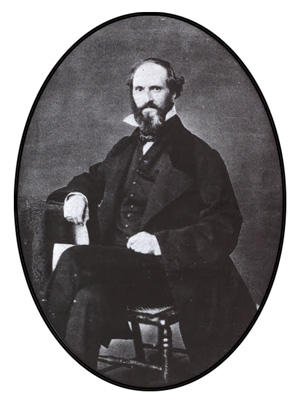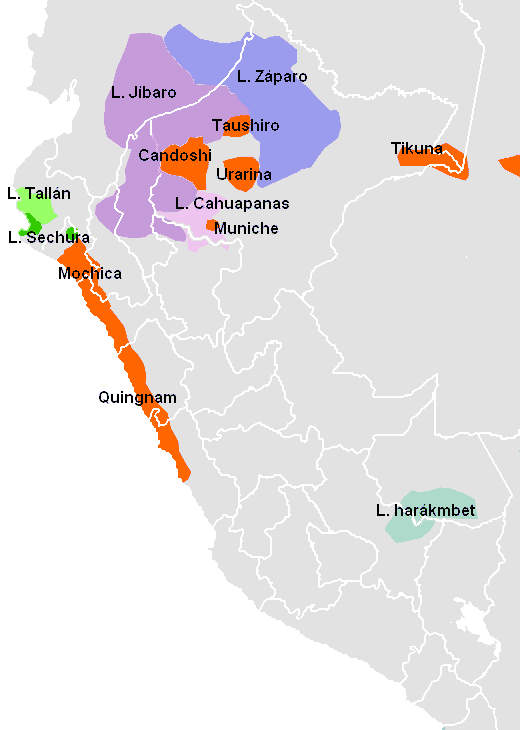|
Sek Language
The Sechura language, also known as Sek, is an extinct language spoken in the Piura Region of Peru, near the port of Sechura. It appears to have become extinct by the beginning of the 20th century. The only documentation is that of an 1863 wordlist by Richard Spruce, as well as a word list by Bishop Martínez Compañón (1782-1790).Martínez Compañón, Baltasar Jaime. 1985 782-1790 ''Trujillo del Perú en el siglo XVIII'', vol. 2. Madrid: Ediciones Cultura Hispánica. Classification Sechura is too poorly known to be definitively classified. Kaufman notes that a connection between Sechura and the Catacaoan languages is likely and is supported by lexical evidence. Sek family Rivet groups Sechura and Tallán together under the same ''Sek'' when he compares them to the Catacaoan languages. In comparing wordlists from Sechura and Tallán, Torero finds six likely cognates between the two: However, ''Glottolog'' says the data is not compelling. Vocabulary Martínez Compañón (1 ... [...More Info...] [...Related Items...] OR: [Wikipedia] [Google] [Baidu] |
Peru
, image_flag = Flag of Peru.svg , image_coat = Escudo nacional del Perú.svg , other_symbol = Great Seal of the State , other_symbol_type = Seal (emblem), National seal , national_motto = "Firm and Happy for the Union" , national_anthem = "National Anthem of Peru" , march = "March of Flags" , image_map = PER orthographic.svg , map_caption = , image_map2 = , capital = Lima , coordinates = , largest_city = capital , official_languages = Peruvian Spanish, Spanish , languages_type = Co-official languages , languages = , ethnic_groups = , ethnic_groups_year = 2017 , demonym = Peruvians, Peruvian , government_type = Unitary state, Unitary Semi-presidential system, semi-presidential republic , leader_title1 = President of Peru, President ... [...More Info...] [...Related Items...] OR: [Wikipedia] [Google] [Baidu] |
Piura Region
Piura () is a coastal department and region in northwestern Peru. The region's capital is Piura and its largest port cities, Paita and Talara, are also among the most important in Peru. The area is known for its tropical and dry beaches. It is the most populous department in Peru, its twelfth smallest department, and its fourth-most densely populated department, after Tumbes, La Libertad, and Lambayeque. The country's latest decentralization program is in hiatus after the proposal to merge departments was defeated in the national referendum in October 2005. The referendum held on October 30, 2005, as part of the ongoing decentralization process in Peru, to decide whether the region would merge with the current regions of Lambayeque and Tumbes to create a new ''Región Norte'' was defeated. Geography The Piura Region is bordered to the north by the Tumbes Region and Ecuador, to the east by Cajamarca Region, to the south by the Lambayeque Region, and to the west by the ... [...More Info...] [...Related Items...] OR: [Wikipedia] [Google] [Baidu] |
Sechura–Catacao Languages
Sechura–Catacao is a proposed connection between the small Catacaoan language family of Peru and the language isolate Sechura (Sek). The languages are extremely poorly known, but Kaufman (1990) finds the connection convincing, Campbell (2012) persuasive. External relationships Kaufman (1994: 64) groups Leco and Sechura–Catacao together as part of a proposed ''Macro-Lecoan'' family.Kaufman, Terrence. 1994. The native languages of South America. In: Christopher Moseley and R. E. Asher (eds.), ''Atlas of the World’s Languages'', 59–93. London: Routledge. Tovar (1961), partly based on Schmidt (1926), classifies Sechura–Catacao together with the Chimuan languages Chimuan (also Chimúan) or Yuncan (Yunga–Puruhá, Yunca–Puruhán) is a hypothetical small extinct language family of northern Peru and Ecuador (inter-Andean valley). Family division Chimuan consisted of three attested languages: * Mochic ... in his ''Yunga–Puruhá'' family. Vocabulary Loukotka (196 ... [...More Info...] [...Related Items...] OR: [Wikipedia] [Google] [Baidu] |
Sechura
Sechura is a city in northwestern Peru, south of Piura. It is the capital of Sechura Province in the Piura Region. The city lends its name to the Sechura Desert The Sechura Desert is a coastal desert located south of the Piura Region of Peru along the Pacific Ocean coast and inland to the foothills of the Andes Mountains. Its extreme aridity is caused by the upwelling of cold coastal waters and subtrop ..., which extends south along most of coastal Peru. Crescent dunes lie south of the city, between the sea and the highway. The city has a main square with the ''Catédral de Sechura'', built in the 18th century in the Spanish colonial style. Because of the desert surrounding the city, the church has sometimes been called the ''Catédral de Arena'' (Sand Cathedral). References Populated places in the Piura Region {{Piura-geo-stub ... [...More Info...] [...Related Items...] OR: [Wikipedia] [Google] [Baidu] |
Richard Spruce
Richard Spruce (10 September 1817 – 28 December 1893) was an English botanist specializing in bryology. One of the great Victorian botanical explorers, Spruce spent 15 years exploring the Amazon from the Andes to its mouth, and was one of the first Europeans to visit many of the places where he collected specimens. Spruce discovered and named a number of new plant species, and corresponded with some of the leading botanists of the nineteenth century. Early life and Career Richard Spruce was born near Ganthorpe, a small village near Castle Howard in Yorkshire. After training under his father, a local schoolmaster, Spruce began a career as a tutor and then as a mathematics master at St. Peter's School, York between 1839 and 1844. Spruce started his botanical collecting in Yorkshire about 1833. In 1834, at age 16, he drew up a neatly written list of all of the plants he had found on trips around Ganthorpe, focusing on bryophytes. Arranged alphabetically and containing 40 ... [...More Info...] [...Related Items...] OR: [Wikipedia] [Google] [Baidu] |
Martínez Compañón
Martínez or Martinez may refer to: Places Argentina * Martínez, Buenos Aires * Coronel Martínez de Hoz, Buenos Aires Province France * Hôtel Martinez, in Cannes Mexico * Martínez de la Torre, Veracruz Spain * Martínez, Ávila, a municipality in the province of Ávila, Castile and León United States * Martinez, California * Martinez, Georgia * Martinez, Texas Other uses * Martinez (band), Swedish dansband * Martinez (cocktail), a cocktail related to the Martini * Martínez (surname) Martínez (often spelled without the acute accent on the "I") is a common surname in the Spanish language. Martínez is the most common surname in the Spanish regions of Navarre, La Rioja, Cuenca and Murcia. There are also variations such as S ... See also * Justice Martinez (other) {{disambig, geo ... [...More Info...] [...Related Items...] OR: [Wikipedia] [Google] [Baidu] |
Catacaoan Languages
The Catacaoan languages are an extinct family of three languages spoken in the Piura Region of Peru. The three languages in the family are: * Catacao or Katakao, once spoken around the city of Catacaos * Colán or Kolán, once spoken between the Piura River and Chira River *Chira or Lachira or Tangarará, once spoken along the Chira River. It is unattested. In Glottolog, the two attested languages, Catacao and Colán, are subsumed into the extinct Tallán language as dialects. Vocabulary comparison Genetic relations Loukota compares Catacaoan to the Culle language and the Sechura language The Sechura language, also known as Sek, is an extinct language spoken in the Piura Region of Peru, near the port of Sechura Sechura is a city in northwestern Peru, south of Piura. It is the capital of Sechura Province in the Piura Region. ... but does not make any claims about genetic relatedness. References {{DEFAULTSORT:Catacaoan Languages Indigenous languages of So ... [...More Info...] [...Related Items...] OR: [Wikipedia] [Google] [Baidu] |
Glottolog
''Glottolog'' is a bibliographic database of the world's lesser-known languages, developed and maintained first at the Max Planck Institute for Evolutionary Anthropology in Leipzig, Germany (between 2015 and 2020 at the Max Planck Institute for the Science of Human History in Jena, Germany). Its main curators include Harald Hammarström and Martin Haspelmath. Overview Sebastian Nordhoff and Harald Hammarström created the Glottolog/Langdoc project in 2011. The creation of ''Glottolog'' was partly motivated by the lack of a comprehensive language bibliography, especially in ''Ethnologue''. Glottolog provides a catalogue of the world's languages and language families and a bibliography on the world's less-spoken languages. It differs from the similar catalogue '' Ethnologue'' in several respects: * It tries to accept only those languages that the editors have been able to confirm both exist and are distinct. Varieties that have not been confirmed, but are inherited from anothe ... [...More Info...] [...Related Items...] OR: [Wikipedia] [Google] [Baidu] |
Wiktionary
Wiktionary ( , , rhyming with "dictionary") is a multilingual, web-based project to create a free content dictionary of terms (including words, phrases, proverbs, linguistic reconstructions, etc.) in all natural languages and in a number of artificial languages. These entries may contain definitions, images for illustration, pronunciations, etymologies, inflections, usage examples, quotations, related terms, and translations of terms into other languages, among other features. It is collaboratively edited via a wiki. Its name is a portmanteau of the words ''wiki'' and ''dictionary''. It is available in languages and in Simple English. Like its sister project Wikipedia, Wiktionary is run by the Wikimedia Foundation, and is written collaboratively by volunteers, dubbed "Wiktionarians". Its wiki software, MediaWiki, allows almost anyone with access to the website to create and edit entries. Because Wiktionary is not limited by print space considerations, most of Wiktio ... [...More Info...] [...Related Items...] OR: [Wikipedia] [Google] [Baidu] |
Languages Of Peru
Peru has many languages in use. One of its official languages, Peruvian Spanish, Spanish, has been in the country since it began being taught in the time of José Pardo y Barreda, José Pardo instead of the country's Native languages, especially the languages in the Andes. In the beginning of the 21st century, it was estimated that in this multilingual country, about 50 very different and popular languages are spoken: which reduces to 44 languages if dialects are considered variants of the same language. The majority of these languages are indigenous peoples, Indigenous, but the most common language is Spanish, the main language that about 94.4% of the population speaks. Spanish is followed by the country's Indigenous languages, especially all types of Quechuan languages, Quechua (11.1% combined) and Aymara languages, Aymara (1.4%), who also have co-official status according to Article 48 of the Constitution of Peru, as well as the languages of the Amazon Basin, Amazon and the Pe ... [...More Info...] [...Related Items...] OR: [Wikipedia] [Google] [Baidu] |


